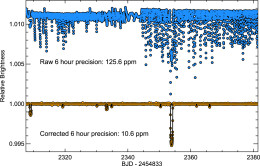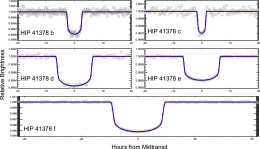What’s the latest from the Kepler K2 mission? K2 has found its first planetary system containing more than three planets — an exciting five-planet system located ~380 light-years from Earth!
Opportunities From K2

Raw K2 light curve (blue, top) and systematic corrected light curve (orange, bottom) for HIP 41378. The three deepest transits are single transits from the three outermost planet candidates. [Vanderburg et al. 2016]
After Kepler’s mechanical failure in 2013, the K2 mission was launched, in which the spacecraft uses solar pressure to stabilize it long enough to perform an 80-day searches of each region it examines. Over the course of the K2 mission, Kepler could potentially survey up to 20 times the sky area of the original mission, providing ample opportunity to find planetary systems around bright stars. These stars may be bright enough to be followed up with other techniques.
Multi-Planet Systems
There’s a catch to the 80-day observing program: the K2 mission is less likely to detect multiple planets orbiting the same star, due to the short time spent observing the system. While the original Kepler mission detected systems with up to seven planets, K2 had yet to detect systems with more than three candidates … until now.
Led by Andrew Vanderburg (NSF Graduate Research Fellow at the Harvard-Smithsonian Center for Astrophysics), a team of scientists recently analyzed K2 observations of the bright star HIP 41378. The team found that this F-type star hosts five potential planetary candidates!

Phase-folded light curve for each of the five transiting planets in the HIP 41378 system. The outermost planet (bottom panel) may provide an excellent target for transmission spectroscopy, to examine its atmosphere. [Vanderburg et al. 2016]
Newly Discovered Candidates
The system’s candidates include two sub-Neptune-sized planets, which were both observed over multiple transits. They orbit in what is nearly a 2:1 resonance, with periods of 31.7 and 15.6 days. Based on modeling of their transits, Vanderburg and collaborators estimate that they have radii of 2.6 and 2.9 Earth radii.
The system also contains three larger outer-planet candidates: one Neptune-sized (~4 Earth radii), one sub-Saturn-sized (~5 Earth radii), and one Jupiter-sized (~10 Earth radii). These planets were detected with only a single transit each, so their properties are harder to determine with certainty. The authors’ models, however, suggest that their periods are ~160 days, ~130 days, and ~1 year.
This system’s brightness, the accessible size of its planets, and its rich architecture make it an excellent target for follow-up observations. In particular, the brightness of the host star and the transit depth of the outermost planet, HIP 41378 f, make this candidate an ideal target for future transit transmission spectroscopy measurements. Since past observations of exoplanet atmospheres have been primarily of short-period, highly irradiated planets, being able to examine the atmosphere of such a long-period gas giant could open up a new regime of exoplanet atmospheric studies.
Citation
Andrew Vanderburg et al 2016 ApJ 827 L10. doi:10.3847/2041-8205/827/1/L10

